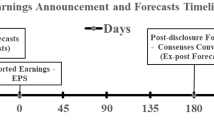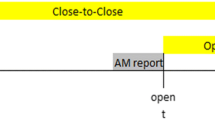Abstract
We investigate the implications of firms’ benchmark-beating patterns with respect to analysts’ quarterly cash flow forecasts for firms’ current capital market valuation and their future performance. We hypothesize that nonnegative earnings surprises are more likely to be supported by real operating performance and signal higher earnings quality if they are achieved via higher than expected cash flows or lower than expected accruals. We show that firms beating analyst earnings forecasts have larger positive capital market reactions and larger earnings response coefficients if they beat analyst cash flow forecasts or report lower than expected accruals. We also demonstrate that these firms’ superior future performance may provide an economic justification for their more favorable market response. Our findings suggest that firms’ ability to beat analyst cash flow forecasts is informative regarding the quality of their earnings surprises.
Similar content being viewed by others
Notes
One reason for the importance of cash flows is that cash flow forecasts (or their mathematical equivalents) underlie firm valuation models (Ohlson 1995).
For simplicity, we use the term “beat” in lieu of the more precise but cumbersome “meet or beat.”.
See FASB Statement of Financial Accounting Concepts No. 1 (1978).
Ghosh et al. (2005) find that firms with revenue-supported earnings increases have higher earnings quality.
We use split-unadjusted I/B/E/S data.
We require all firm-quarters to have at least one cash flow forecast and one earnings forecast in I/B/E/S. The former requirement makes our sample relatively small vis-à-vis samples that simply require at least one earnings forecast.
Unlike good news earnings and good news cash flows which are represented by nonnegative ES and CS respectively, good news accruals is represented by negative AS. In contrast to good news earnings and cash flows, the accruals surprise is good news if actual accruals are below predicted accruals. Conceptually, for a given earnings surprise, the larger the accruals component is, the less the earnings surprise is supported by cash flow performance, which implies lower earnings quality. We therefore classify greater than expected accrual surprises (AS >0) as bad news accruals and all other cases as good news accruals. Our resulting GNA variable theoretically captures not only absence of earnings management but also cases of downward earnings management. On the one hand, one can view any type of earnings management, including downward earnings management, as a negative signal, i.e., as bad news. On the other hand, downward earnings management may not be bad news in our meet-or-beat setting if the firm would have met the earnings target even in the absence of downward earnings management. In addition, while downward earnings management may be undesirable from an accounting standpoint, the market may favorably view a firm’s ability to manage earnings downward to build “cookie jar reserves.” Indeed, extant evidence indicates the market rewards earnings smoothing (Kirschenheiter and Melumad 2002) and upward earnings management is regarded as more egregious than downward earnings management (Eccles et al. 2001; Levitt 1998). Hence, the concern that our definition of good news accruals reflects downward earnings management cases is mitigated. Nevertheless, to the extent our GNA variable is noisy by encompassing downward earnings management cases, and the market is concerned about downward earnings management, our ability to obtain results for hypotheses tests is weakened. That is, ceteris paribus, one would not expect a greater market response to good news earnings when AS <0 (GNE_GNA) than when AS >0 (GNE_BNA) if downward earnings management renders the AS <0 accruals surprise to be perceived as negatively as the AS >0 accruals surprise.
Unlike Melendrez et al. (2008) who measure cumulative size-adjusted returns from 1 day after the last I/B/E/S forecast summarization date before fiscal year-end to 90 days after fiscal year-end, we use a short 3-day window. In addition, unlike Melendrez et al. (2008) who do not require the earnings announcement date to be close to the cash flow announcement date, we require cash flows to be announced within 1 day of earnings to ensure we properly capture the market response to both the cash flow and earnings announcement.
Melendrez et al. (2008) only examine future earnings performance. We examine both future return on assets and future cash flow performance.
The mean difference is significant at the 0.10 level and the median difference is significant at the 0.001 level.
Bartov et al. (2002) find ES to be statistically significant. The fact that ES is not statistically significant in our Model 2 may be due to differences between our sample and the one used in Bartov et al. (2002). For example, we investigate a more recent time period than Bartov et al. (2002) do. In addition, unlike Bartov et al. (2002), our sample is limited to firm-quarters with analysts’ cash flow forecasts and actual cash flow data on I/B/E/S, and we impose the requirement that actual earnings are released within 1 day of actual cash flows.
References
Ball R, Brown P (1968) An empirical evaluation of accounting income numbers. J Account Res 6(2):159–178
Bartov E, Givoly D, Hayn C (2002) The rewards to meeting or beating earnings expectations. J Account Econ 33(2):173–204
Bowen R, Rajgopal S, Venkatachalam M (2008) Accounting discretion, corporate governance, and firm performance. Contemp Account Res 25(2):351–405
Brown L (2007) Editor, Thomson financial research bibliography. First Edition
Brown L, Caylor M (2005) A temporal analysis of quarterly earnings thresholds: propensities and valuation consequences. Account Rev 80(2):423–440
Brown L, Kim KJ (1991) Timely aggregate analyst forecasts as better proxies for market earnings expectations. J Account Res 29(2):382–385
Brown L, Pinello A (2007) To what extent does the financial reporting process curb earnings surprise games? J Account Res 45(5):947–981
Call A, Chen S, Tong Y (2009) Are analysts’ earnings forecasts more accurate when accompanied by cash flow forecasts? Rev Account Stud 14(2–3):358–391
Cheng A, Hollie D (2008) Do core and non-core cash flows from operations persist differentially in predicting future cash flows? Rev Quant Finan Account 31(1):29–53
Collins D, Kothari S (1989) An analysis of intertemporal and cross-sectional determinants of earnings response coefficients. J Account Econ 11(2–3):143–181
Core J, Holthausen R, Larcker D (1999) Corporate governance, chief executive officer compensation, and firm performance. J Financ Econ 51(3):371–406
Dechow P (1994) Accounting earnings and cash flows as measures of firm performance: the role of accounting accruals. J Account Econ 18(1):3–42
Dechow P, Dichev I (2002) The quality of accruals and earnings: the role of accrual estimation errors. Account Rev 77(Supplement):35–59
DeFond M, Hung M (2003) An empirical analysis of analysts’ cash flow forecasts. J Account Econ 35(1):73–100
Dopuch N, Seethamraju C, Xu W (2008) An empirical assessment of the premium associated with meeting or beating both time-series earnings expectations and analysts’ forecasts. Rev Quant Finan Account 31(2):147–166
Easton P, Zmijewski M (1989) Cross-sectional variation in the stock market response to accounting earnings announcements. J Account Econ 11(2):117–141
Eccles R, Herz R, Keegan E, Phillips D (2001) The value reporting revolution: moving beyond the earnings game. Wiley, New York
Ertimur Y, Livnat J, Martikainen M (2003) Differential market reactions to revenue and expense surprises. Rev Account Stud 8(2–3):185–211
Financial Accounting Standards Board (1978) Objectives of financial reporting by business enterprises. FASB Statement of Financial Accounting Concepts No. 1. FASB, Norwalk
Ghosh A, Gu Z, Jain P (2005) Sustained earnings and revenue growth, earnings quality, and earnings response coefficients. Rev Account Stud 10(1):33–57
Givoly D, Hayn C, Lehavy R (2009) The quality of analysts’ cash flow forecasts. Account Rev 84(6):1877–1911
Graham J, Harvey C, Rajgopal S (2005) The economic implications of corporate financial reporting. J Account Econ 40(1–3):3–73
Healy P (1985) The effect of bonus schemes on accounting decisions. J Account Econ 7(1–3):85–107
Kasznik R, McNichols M (2002) Does meeting earnings expectations matter? Evidence from analyst forecast revisions and share prices. J Account Res 40(3):727–759
Keung E, Lin Z, Shih M (2010) Does the stock market see a zero or small positive earnings surprise as a red flag? J Account Res 48(1):105–135
Kinney W, Burgstahler D, Martin R (2002) Earnings surprise “materiality” as measured by stock returns. J Account Res 40(5):1297–1329
Kirschenheiter M, Melumad N (2002) Can “big bath” and earnings smoothing co-exist as equilibrium financial reporting strategies? J Account Res 40(3):761–796
Koh K, Matsumoto D, Rajgopal S (2008) Meeting or beating analyst expectations in the post-scandals world: changes in stock market rewards and managerial actions. Contemp Account Res 25(4):1067–1098
Kothari S, Leone A, Wasley C (2005) Performance matched discretionary accrual measures. J Account Econ 39(1):163–197
Levitt A (1998) The numbers game. Speech delivered at NYU Center for Law and Business, New York, 28 Sept
Lipe R (1990) The relation between stock returns and accounting earnings given alternative information. Account Rev 65(1):49–71
Lopez T, Rees L (2002) The effect of beating and missing analysts’ forecasts on the information content of unexpected earnings. J Account Audit Financ 17(2):155–184
Lorek K, Willinger L (2009) New evidence pertaining to the prediction of operating cash flows. Rev Quant Finan Account 32(1):1–15
McInnis J, Collins D (2011) The effect of cash flow forecasts on accrual quality and benchmark beating. J Account Econ 51(3):219–239
Melendrez K, Schwartz W, Trombley M (2008) Cash flow and accrual surprises: persistence and return implications. J Account Audit Financ 23(4):573–592
Minton B, Schrand C, Walther B (2002) The role of volatility in forecasting. Rev Account Stud 7(2–3):195–215
O’Brien P (1988) Analysts’ forecasts as earnings expectations. J Account Econ 10(1):53–83
Ohlson J (1995) Earnings, book values, and dividends in equity valuation. Contemp Account Res 11(2):661–687
Philbrick D, Ricks W (1991) Using value line and IBES analyst forecasts in accounting research. J Account Res 29(2):397–417
Ramnath S, Rock S, Shane P (2008) The financial analyst forecasting literature: taxonomy with suggestions for further research. Int J Forecast 24(1):34–75
Skinner D, Sloan R (2002) Earnings surprises, growth expectations, and stock returns or don’t let an earnings torpedo sink your portfolio. Rev Account Stud 7(2–3):289–312
Sloan R (1996) Do stock prices fully reflect information in accruals and cash flows about future earnings? Account Rev 71(3):289–315
Acknowledgments
We appreciate the helpful comments from workshop participants at Arizona State University and McMaster University. A prior version of this paper benefited from the comments of workshop participants at the 2009 Annual Meeting of the American Accounting Association, the 2008 Southeast Summer Accounting Research Colloquium, the 2008 Mid-South Doctoral Consortium, Louisiana State University, and University of South Carolina. We are grateful for valuable comments of Marcus Caylor, Agnes Cheng, Tom Lopez, and Mohan Venkatachalam.
Author information
Authors and Affiliations
Corresponding author
Rights and permissions
About this article
Cite this article
Brown, L.D., Huang, K. & Pinello, A.S. To beat or not to beat? The importance of analysts’ cash flow forecasts. Rev Quant Finan Acc 41, 723–752 (2013). https://doi.org/10.1007/s11156-012-0330-z
Published:
Issue Date:
DOI: https://doi.org/10.1007/s11156-012-0330-z




